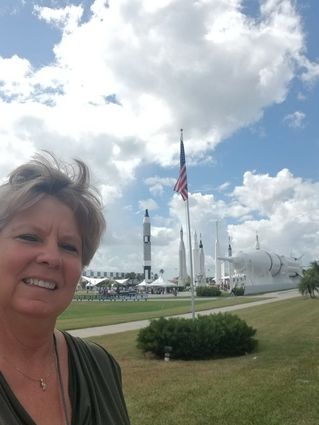Ewing educator gets first-hand glimpse at space exploration
August 1, 2019

Courtesy photo
Lift off • Ewing Public Schools science instructor Krista Holliday recently attended a three-day workshop at Kennedy Space Center near Cape Canaveral on Merritt Island, Fla. Upcoming space expeditions, including a 2024 launch to the moon, and eventually, Mars, will reinvigorate the space program.
Space, according to the Star Trek monologue, is be the final frontier.
Krista Holliday, 7-12 grade science instructor may agree, after spending three days at a workshop at Kennedy Space Center, July 23 to 25.
The conference's theme - Space 2019 - focused on how to implement space exploration in the classroom.
Computers used to fly the Apollo missions had 1,000 kilobytes.
"That's like one megabyte. Our smartphones have four gigabytes," Holliday said. "If you think about that, it's amazing with the technology we had that we were able to do that."
Holliday was one of several Nebraska educators who received a NASA Nebraska Space Grant to attend the conference.
Since 1991, the consortium has successfuly promoted aerospace-related activities.
In addition to daily sessions, attendees took a behind-the-scenes tour of the space center.
"We toured the vehicle assemly building, where they build rockets."
Holliday said the building is one of the largest one-story buildings in the world by area.
According to NASA, it covers eight acres, measuring 525 feet tall and 518 feet wide.
The accordian-style bay doors are 456 feet high and take approximately 45 minutes to completely open or close.
Stripes on an American flag, painted on the side of the building, are as wide as a car. The 209-foot-tall by 110-foot-wide flag is the largest version of the stars and stripes.
It was in the VAB, where Apollo/Saturn V was constructed.
"Rockets were rolled out on caterpiller treads to the launch pad," she said.
The launch site was slightly more than three miles away.
During the conference, Holliday listened to astronauts and NASA experts share stories about space.
Al Worden, command module pilot for Apollo 15, "gave an interesting speech about his journey," she said.
Sam Durrance, a scientist, flew on Columbia and Endeavour NASA space shuttle missions as a payload specialist.
The launch director of the exploration ground systems program, Charlie Blackwell Thompson, also spoke during the conference.
"She will oversee the 2024 mission to the moon, called Exploration Mission-1," Holliday said.
NASA's eventual goal is to launch an expedition to Mars from the moon.
Another goal NASA has set: Have a female walk on the moon.
"A female has never stepped on the moon," she said. "One of th things they want to do the first times they go back is get a woman on the moon."
While in Florida, Holliday viewed the launch of a Falcon 9 rocket, boosting a Dragon cargo ship headed for the International Space Station, owned by SpaceX and financed by Elon Musk.
Onboard the Dragon were 5,000 pounds of equipment and supplies, including an automated 3D cardiac tissue printer, research for the Goodyear Tire Company and a bucket of green Nickelodeon slime, which will be utilized in experiments for students.
"The rocket came back down and landed at Cape Canaveral. It will be used again," she said.
Holliday said the 50th anniversary of the Apollo moon landing, along with future missions, have renewed interest in space exploration.
"There's a lot going on in space and NASA that I had no clue about, and now I'm excited to share it with students."
Space - and all its vastness - isn't limited to science education.
"It's going to help them historically. The history behind everything is phenomenal," Holliday said. "But technology-wise, I can get materials to use in the classroom. I have hands-on activities they can do and build, work on physics and math."
Holliday said job opportunities with NASA span multiple fields.
"Things you don't think about. You also have welders at the vehicle assembly building, crane operators, computer and tech people," Holliday said. "The actual astronauts and computer programmers are just a small piece. It takes a whole country to build."



Reader Comments(0)